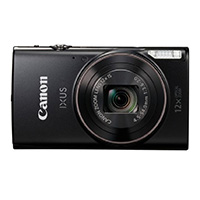Digital Cameras
If you have yet to buy a digital camera, and are unsure what all the fuss is about, we answer the essential FAQs about digital cameras below. You will also find links to some of the best sites for buying a digital camera in the UK.
Buying a product online can save you time and money.
|
How is a digital camera different from a traditional camera, and what's so good about digital cameras anyway?
A digital camera doesn't need any film, instead it stores the photos it takes as electronic files on an internal memory card. The photos can then be transferred to a computer and printed out on its printer. New digital cameras may also have PictBridge technology which allows the photos to be transferred directly from the digital camera to a PictBridge enabled printer.
How do I connect a digital camera to a computer?
A digital camera usually comes with the cable to connect it to the computer, along with some software that needs to be loaded onto the computer to manage the transfer (or download) process. Cable connection standards that are used include USB and Firewire (better because it's faster). Some computers also have memory card readers, which are like disk drives and accept the memory card from the digital camera. The best digital cameras are starting to use WiFi technology, so if your computer is wireless enabled, you can transfer the photos to your computer without the need for a cable.
There is also a new technology called PictBridge, which allows the direct connection of a PictBridge enabled digital camera to a PictBridge enabled printer, for the printing of photos - a good option if you don't like computers!
What are megapixels, and how many megapixels are recommended for digital cameras?
When you take a digital photo, the picture is stored electronically as millions of red, blue and green squares. Each of these squares is known as a pixel, and a megapixel is equivalent to a million pixels. The more pixels your camera uses, the higher the quality of the pictures it can take. Ratings are given as megapixels because the number of pixels involved is so large. The number of megapixels recommended for your digital camera depends on the quality of photo you require. Below is a rough guide:
| Number of Megapixels | Suitable For |
| 1 | Digital photos for websites or E-mails |
| 2 | Acceptable for 4x6" prints |
| 3 | Good for 4x6" prints, acceptable for 5x7" prints (comparable to quality of 35mm photos) |
| 4 | Good for 5x7" prints, acceptable for 8x10" prints |
| 5 | Good for 11x14" prints, acceptable for 12x18" prints |
What features should I look for in recommended digital cameras?
Below we review the most important features any recommended digital camera should have (in approximate order of importance!)
Digital Camera Power Options and Battery Life
One of the problems with digital cameras is that they can drain the batteries quickly, so pay careful attention to battery life when reading digital camera reviews. Most digital cameras use AA batteries, and to save money on disposable alkaline batteries, you can use rechargeable NiCD or NiMH AA batteries instead.
The best digital cameras have their own rechargeable Lithium-Ion batteries. These generally last longer, but one problem is that they will only fit the camera they were designed for. It can therefore be difficult to buy replacements, so it's a good idea to buy a spare. The digital camera may come with a docking cradle that connects to your computer to allow picture downloading and recharging of the camera.
Viewfinder and LCD Display Screen Size
Whilst most digital cameras have an LCD screen which can be used as a viewfinder (and to display the photos that have been taken), these are a big drain on battery power. It's therefore best to choose a digital camera that also has a traditional viewfinder so that you don't have to have the LCD screen on all the time. LCD screens vary in size from 1.6 to 3 inches (across the diagonal). It's nice to have a big screen, but bear in mind it will affect battery life.
Digital Camera Memory Cards
A digital camera uses a memory card to store the photos you take. The memory card is held in an expansion slot inside the digital camera. The most common types of memory card are Compact Flash, MultiMedia Card, Secure Digital, xtreme Digital and Memory Stick (a Sony proprietary format).
The capacity of the memory card supplied with cheap digital cameras may be as little as 8MB, which will only hold a few photos at the highest quality setting. You will probably need at least a 128MB memory card, so budget to buy one of these if necessary.
Zoom
If you require a zoom, then assess the digital camera on the basis of optical zoom and not digital zoom. Optical zoom is achieved through the lens optics just as in a traditional camera and gives good results, whereas digital zoom is achieved through software and results in pixelation (i.e. images become grainy) at high zoom.
A 3x optical zoom with be enough for general purposes, although you may need 5x or more for specialist purposes such as wildlife photography.
Focus Options
Most digital cameras have auto focus whereby whatever is in the centre of the viewfinder is brought into focus.
If you wish to take close ups of objects, make sure the digital camera has a Macro mode, which allows close-up items to be focused upon.
The best digital cameras also offer manual focusing, which is useful when the auto focus system is struggling. However, manual focus is not required by most people.
Pict Bridge Direct Printer Connection Technology
Pict Bridge is a relatively new feature quickly becoming available across a wide range of digital cameras, and allows a direct connection between the digital camera and PictBridge enabled printer. Software on the digital camera allows you to select the photos you wish to print.
Movies
Even many cheap digital cameras come with a movie mode that allows a couple of minutes of video shooting. This is saved as an mpg movie file that can be transferred and viewed on your computer. Often though sound is not recorded in these video modes, and the quality won't be comparable to dedicated digital camcorders, which we'd recommend you buy instead if you are interested in shooting video.
What if I have photos on old film negatives that I want to turn into digital images?
This can be done with a slide scanner.
Thanks for visiting Navito UK Shopping.


